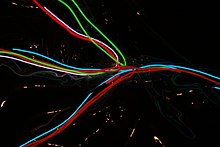Electroluminescent foil
Electroluminescent film ( EL film for short ), also called luminous or plasma film , luminous film or capacitor luminous film , is a technical application of electroluminescence for converting electrical energy into light.
Basics
Electroluminescence is the property of certain materials or combinations of materials to emit light when an electric field is applied. In the case of the electroluminescent film, a semiconductor in a special capacitor configuration is excited to glow by an alternating electric field . The electroluminescent film is a Lambert radiator .
construction
The basic structure of an electroluminescent film is similar to that of a plate capacitor : the electroluminescent material is electrically insulated between two conductive layers (electrodes). An electrode is translucent and usually consists of a plastic film coated with indium tin oxide. The second film reflects the light. The total thickness is less than 1 mm. Construction:
- Plastic protective film
- Transparent conductive film
- Insulating material with embedded phosphor
- Metal foil
- Plastic protective film
The electroluminescent phosphor is usually zinc sulfide , a II-VI compound semiconductor that is doped with various metals such as manganese ( ZnS: Mn ), gold , silver , copper or gallium . White light is usually created by superimposing brightly colored pigments.
The electroluminescent and insulating layers can be applied by screen printing . Elongated, round shapes (fluorescent tubes, EL cables, English electroluminescent wire ) are also produced, in which the alternating field is generated between a central wire and layers attached to it.
The phosphor degrades when it comes into contact with moisture. The surfaces are protected by welded plastic films that should not be damaged. On the other hand, light tubes can be shortened, since only the cut surface is damaged.
business
The materials of an EL film are insulating with DC voltage and do not light up. The operation of EL foils and cables requires a sinusoidal alternating voltage. Depending on the design, the operating voltage is between 30 and 300 volts at a frequency between 50 Hz and 4 kHz. The brightness and, to a lesser extent, the color and the service life depend on the amplitude and frequency of the alternating voltage. For example, the service life is halved when the frequency is doubled. In order to maintain optimal operating conditions, manufacturers usually offer their films together with matched inverters .
The light emission takes place without significant heat development, over a large area, non-directional and with low luminance. The power consumption is approx. 1 to 2 A / m². The field strength is 10 kV / cm, corresponding to approx. 100 V with a layer thickness of 0.1 mm.
Typical parameters:
| tension | 30 - 160 V |
| frequency | 100-2000 Hz |
| Luminance | 30 to 200 cd / m² |
| Power consumption | 0.15 mA / cm² |
| Power consumption | 10-20 mW / cm² |
| Power consumption for 1 A4 area | 6 W |
| Working temperature | −40 ° to 60 ° |
| Light output | 0.47 - 6.3 lm / W |
| Total thickness | <1 mm |
| Radius of curvature | <20 mm |
| wavelength | 450 to 750 nm |
| lifespan | > 10,000 h |
application
EL foils and cables shine flat, but not very bright. The luminance decreases over time. The service life is specified as the operating time after which it has dropped by half.
The application possibilities are very versatile due to the extraordinary properties.
Examples:
- Safety lighting (stair profile)
- Costumes
- Luminous license plates
- Luminous speedometer dials
- Display backlighting in liquid crystal screens (LC displays) and thin film transistor displays (TFT displays)
- Night lighting .
- In a crush-resistant and slip-resistant laminate as floor graphics
- As a flatfield generator for recording flat frames for astrophotography




